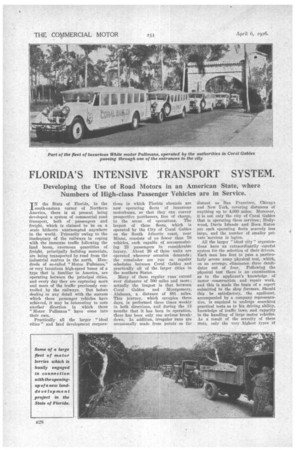FLORIDA'S INTENSIVE TRANSPORT SYSTEM.
Page 12

Page 13

If you've noticed an error in this article please click here to report it so we can fix it.
Developing the Use of Road Motors in an American State, where Numbers of High-class Passenger Vehicles are in Service.
IN the State of Florida, in the south-eastern corner of Northern America, there is at present being developed a system of commercial road transport, both of passengers and freight, which is claimed to be on a scale hitherto unattempted anywhere in the world. Primarily owing to the inadequacy of the railways in coping with the immense traffic following the land boom, enormous quantities of freight, principally building materials, are being transported by road from the industrial centres in the north. Hundreds of so-called "Motor Pullmans," or very luxurious high-speed buses of a type that is familiar in America, are operating between the principal cities, and every day they are capturing more and more of the traffic previously con.trolled by the railways. But before , dealing in any detail with the success which these passenger vehicles have achieved, it may be interesting to note another direction in which these "Motor Pullmans" have come into their own.
Practically all the larger "ideal cities" and land development corpora
tions in which Florida abounds are now operating fleets ' of luxurious motorbuses, so that they can convey prospective purchasers, free of charge, to the scene of operations. The largest of these fleets, which is operated by the City of Coral Gables on the South Atlantic coast, near Miami, consists of 110 fewer than 70 vehicles, each capable of accommodating 23 passengers in considerable luxury. About 20 of these units are operated . wherever occasion demands ; the remainder are run on regular schedules between Coral Gables and practically all of the larger cities in the southern States.
Many of these regular runs extend over distances of 500 miles and more ; actually the longest is that between Coral Gables and Montgomery, Alabama, a distance of 881 miles. This journey, which occupies three days, is performed three times weekly in both directions, and during the 18 months that it has been in operation, there has been only one serious breakdown. In addition, irregular runs are occasionally made from points so far
distant as San Francisco, Chicago and New York, covering distances of anything up to 4,000 miles. Moreover, it is not only the city of Coral Gables that is operating these services ; Hollywood, Davis Islands and Boca Raton are each operating fleets scarcely less large, and the number of smaller private 'services is legion.
All the larger "idealcity" organizations have an extraordinarily .careful system for the selection of their drivers. Each man has first to pass a particularly severe army physical test, which, on an average, eliminates three candidates out of four.. Following the physical test there is an examination as to the applicant's knowledge of motor construction and repair work, and this is made the basis of a report submitted to the shop foreman. Should this be satisfactory, the applicant, accompanied by a company representative, is required to undergo searching practical tests as to his driving ability, knowledge of traffic laws, and capacity in the handling of large motor vehicles. As a result of the severity of these tasts, only the very highest types of
driver are taken into service, and there can be little doubt that much of the popularity of mechanical road transport in Florida to-day is due to this high ,standard.
To English ideas, the enormous extent to which these free services are operated—it, is said that one of the larger land corporations spent $2,000,000 last year in passenger transport alone—is, perhaps, the most remarkable aspect of the Florida transport boom, the.develoPment Of comniercial 'passenger. services between the larger cities is scarcely Tess extraordinary.' .Between Miami: ad Palm Ileach—a distance of 70 miles—an hourly service is in operation on a t,cliedule 'of 130 minutes' running time. Frequent -buses run throughout the day between Miami and Tampa, and there
arc morning and evening servic.es between Miami and Jacksonville, which: are 370 miles apart._ The whole State is, in fact, a network Of long-distance bus routes. As the majority of these vehicles are capable of' anything up to 60 miles an hOur, and as the official. speed limit is 45 miles an hour, their speeds, in many cases,. compare favourably with those of the railways.
The State of Florida, being entirely, fiat and blessed with excellent roads built out of the natural foundation of coral rock, is particularly suited to the .development of heavy passenger trans.: port, more especially as there is general recognition of the essential part which these services play in the State's development and, as a result, practically no anti-motoring legislation.
The remarkable amount of freight
traffic on Florida roads, resulting principally from the building boom, -is a revelation to visitors from other parts of the United States. Contractors who have been compelled, often against their, more conservative instinets, to utilize fleets of motor lorries in order to complete their contracts on time, have discovered, in many cases, that the saying and convenience effected by so doing justify them in obtaining more vehicles and in abandoning the railways altogether. A direct and 'obviou result has been much improvement in the railway services in order to keep pace with this competition. Business Men and the public generally fully realize the great service which the motor companies have performed in providing a highly satisfactory means of transport.
































